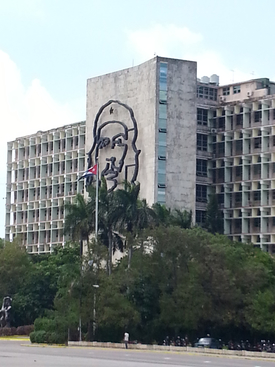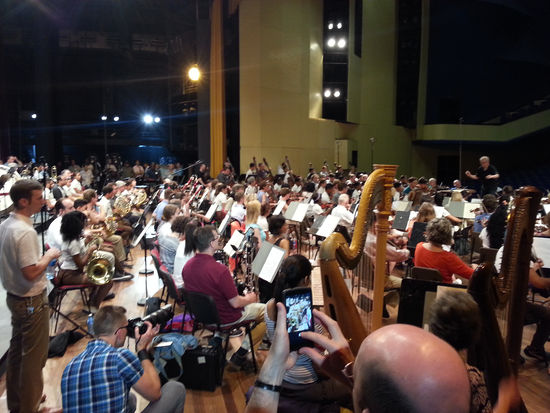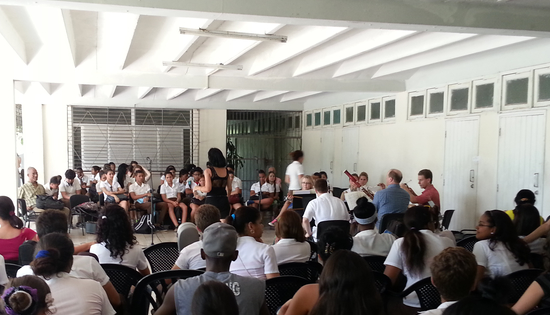Only a few weeks after President Obama announced that relations between Cuba and the USA would be normalized, the Minnesota Orchestra began working on the prospect of a tour. With the help of many parties—and in particular the Orchestra’s artistic staff, along with the experience of the Orchestra’s touring company, Classical Movements, in traveling to Cuba—the tour became a reality just five months after normalization had begun.
Any orchestra tour is complex. Most are planned two, three or more years out. This one, covering an intense four nights and five days, with all the additional requirements of cultural exchange and person-to-person contact required by the various government agencies, was planned minutely, and with successful outcome, in only a few weeks.
The timing was superb: musicians agreed to give up a May vacation week so the orchestra could join this year’s Cubadisco festival (somewhat akin to our Grammys) as a featured performer.
The Tour Group
The entire group, 165 people, traveled all together on a unique Delta charter flight—unique because Delta assured us it was the very first nonstop flight between MSP and HAV, that is, between the Twin Cities and Cuba. It was the first of a number of firsts.
On board were 105 musicians, nine administrators, one tour doctor, and five stagehands, including a retired audio specialist brought for his expertise in making necessary adjustments in the multi-purpose hall in which we performed. Nothing particularly unusual so far. In addition, there were eight local and national press, reporters and photographers; five broadcast personnel from MPR, the local public radio behemoth that produced and simulcast each concert live both in Havana and ‘locally’ in the Twin Cities; three local and national PR people; and five members of the touring company.

Photo credit: Paul Gunther
Finally, several members of the Board of Directors, as well as local community members, joined the tour under the auspices of People to People International. One of the purposes of collecting this disparate group together for our shared experience was to drive home the fact that after months of darkness, not only is healing taking place in the local Twin Cities symphony community, but also the Minnesota Orchestra—staff, musicians, administration, and board—is able to accept new challenges, and rise together to meet them. This group joined the main part of the tour only for some meals and for the two concerts; otherwise, they had a separate planned itinerary.
The charter flight carried not only the usual large assortment of personal luggage and orchestra touring trunks, wardrobes and instrument cases, but also an acoustic shell, borrowed from a local high school and wrangled on board by the stagehands, in order to help manage the hall’s sound.
The Music
In Havana we scheduled two formal concerts and a side-by-side rehearsal, all at the Teatro Nacional, a 2000-seat multi-purpose auditorium built in 1953. On Monday in Minneapolis we had two rehearsals covering the entire repertoire. Additionally there was a separate Havana rehearsal for each performance, scheduled in and around several other prescribed activities. Both concerts were sold-out.
The side-by-side rehearsal took place Friday morning on a very crowded stage, every Minnesota musician paired with a student musician from the Orquesta Sinfónica Juvenil del Conservatorio Amadeo Roldán (Roldán Conservatory Youth Orchestra). The repertoire was chosen because the youth orchestra would be performing it themselves later as part of the festival: Tchaikovsky Romeo & Juliet and Borodin Polovtsian Dances, conducted by Music Director Osmo Vänskä; and Guaguancó, composed by the youth orchestra conductor Guido López Gavilán. Of the 30 minutes utilized to rehearse his five-minute piece, Mo. Gavilán spent 25 minutes teaching the Minnesotans how to play the overlapping layered Cuban rhythms essential to the piece’s performance, with great success in the final five-minute run-through.

Side-by-side rehearsal with the Roldán Conservatory Youth Orchestra
Photo credit: Paul Gunther
On Friday, May 15, in a partial reprise of the very first concert the Orchestra (then the Minneapolis Symphony) performed in Havana in 1929, there was an all-Beethoven concert: the Egmont Overture, the Choral Fantasy with Cuban soloist and choir, and the Eroïca Symphony. Well, not quite all-Beethoven, as we finished with an encore, a traditional Finnish polka orchestrated by Osmo.
Saturday’s concert was quite different, with a number of significant pairings, real and symbolic. Perhaps the most remarkable was the back-to-back performance of the two national anthems, possibly the first time by a symphony orchestra in Havana, and quite surely the only time in the last sixty years. Like “The Star-Spangled Banner”, the Cuban anthem “La Bayamesa” arose out of a period of revolution and quest for independence—the one in the nineteenth century, not the twentieth. After opening with Caturla’s Danzón, the Orchestra played West Side Story Symphonic Dances (Sharks and Jets); and after intermission performed Vänskä’s suite from Prokofiev’s complete Romeo and Juliet (Montagues and Capulets). Then the encores: two more short Cuban works and the Finnish polka further warmed the already tropical evening.
The Exchange
While the overall purpose of this journey was to perform our music in Havana, the tour coalesced into a multi-layered cultural exchange. For me this represented the two most unexpected aspects of the trip: the welcoming warmth of the Cubans, and the music. Music seemed to be everywhere we went, and certainly part of that is because visits were arranged for us that included music both in public spaces as well as in private.
The entire first morning was spent with half our group at each of two of Cuba’s schools for the arts sharing one large campus: the Escuela Nacional de Arte (high school) and the Instituto Superior de Arte (college). At each school we heard performances by the students, conducted master classes for the students, and performed chamber music for them. Despite being hampered by lack of both equipment and high-quality instruments, these students, like the ones playing with us at the side-by-side the next day, displayed remarkably high levels of musicianship. Minnesota musicians brought personal gifts to leave with the students, such hard-to-get (in Cuba) items as strings, reeds and mallets, and exchanged e-mail addresses. (I brought and left with Mo. Gavilán several extra sets of orchestra parts, for the youth orchestra.)

Wendy Williams (Flute), Julie Gramolini Williams (Oboe), Matt Wilson (Horn), Chris Marshall (Bassoon), and Greg Williams (Clarinet) perform at the Escuela Nacional de Arte
Photo credit: Paul Gunther
A completely unexpected bonus was planned for us by the wonderful people at our tour company, in the form of professional ensembles hired to perform during two of our group dinners, and at the hotel after our final concert. The chorus who sang for us the first night at the Hotel Nacional before dinner, Coro Entrevoces, was part of the choir in the Choral Fantasy at our Beethoven concert, and will tour to Minnesota in July to perform with us again. Some of our musicians (including Osmo on clarinet) sat in and jammed with traditional Cuban groups.
The Finale
Keeping in mind that this tour took place just sixteen months after a sixteen-month lockout ended, something quite unusual occurred the last night we were there. Accustomed though we are to appreciative audiences while touring abroad (and very likely anyone in an orchestra who has toured internationally will have experienced that as well), we found ourselves being appreciated after our second concert in a most unanticipated way.
At the end of the concert musicians, photographers, friends old and new, and audience members crowded on- and backstage to shower warm greetings on each other. Gradually, the musicians said their farewells, changed clothes, packed up their instruments, and made their way out to the buses. One by one, at intervals of several minutes, each of the four musician buses was filled and departed for the hotel.

The author in front of the Monument to José Martí in Havana
Photo credit: Fernando Meza
Then, as we arrived, one by one each bus was met outside the hotel by our People to People group of Board members, community representatives, and friends and supporters from Minneapolis who had accompanied the tour and attended the concerts. As the first bus arrived, they clustered outside the door, greeting each musician as they exited with smiles, applause and cheers. When the first bus had pulled away, they waited for the second, third and fourth with the same appreciative welcome.
Being the tour librarian requires time to collect and count folders and verify that nothing critical is left behind (tempting though it may have been to stay a few more days). Yet, although I was on the third of the four buses, and the last person off that bus, there they were, our tour companions and supporters from back in Minneapolis, cheering and smiling and applauding. For me. It was perhaps the most astonishing moment of the entire extraordinary trip, an experience that only months earlier I could scarcely have credited would be possible.
Though without definite plans, I am very much looking forward to returning to Cuba.






[…] States to visit South Africa. Following our historic—and for the orchestra, transformational—tour to Cuba in 2015, and Maestro Osmo Vänskä’s previous experience as a guest conductor for the South […]